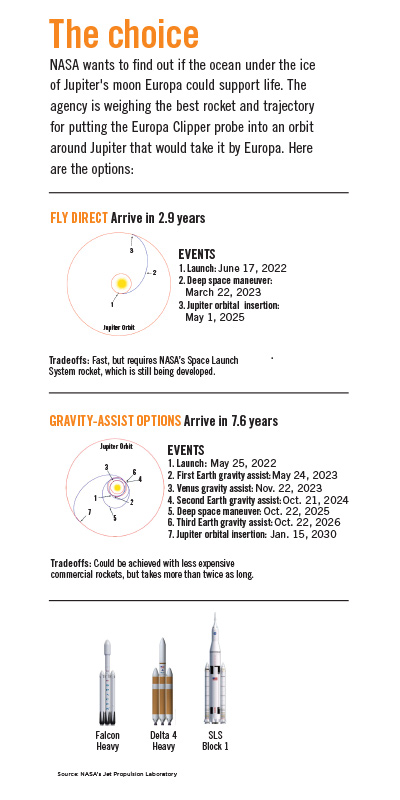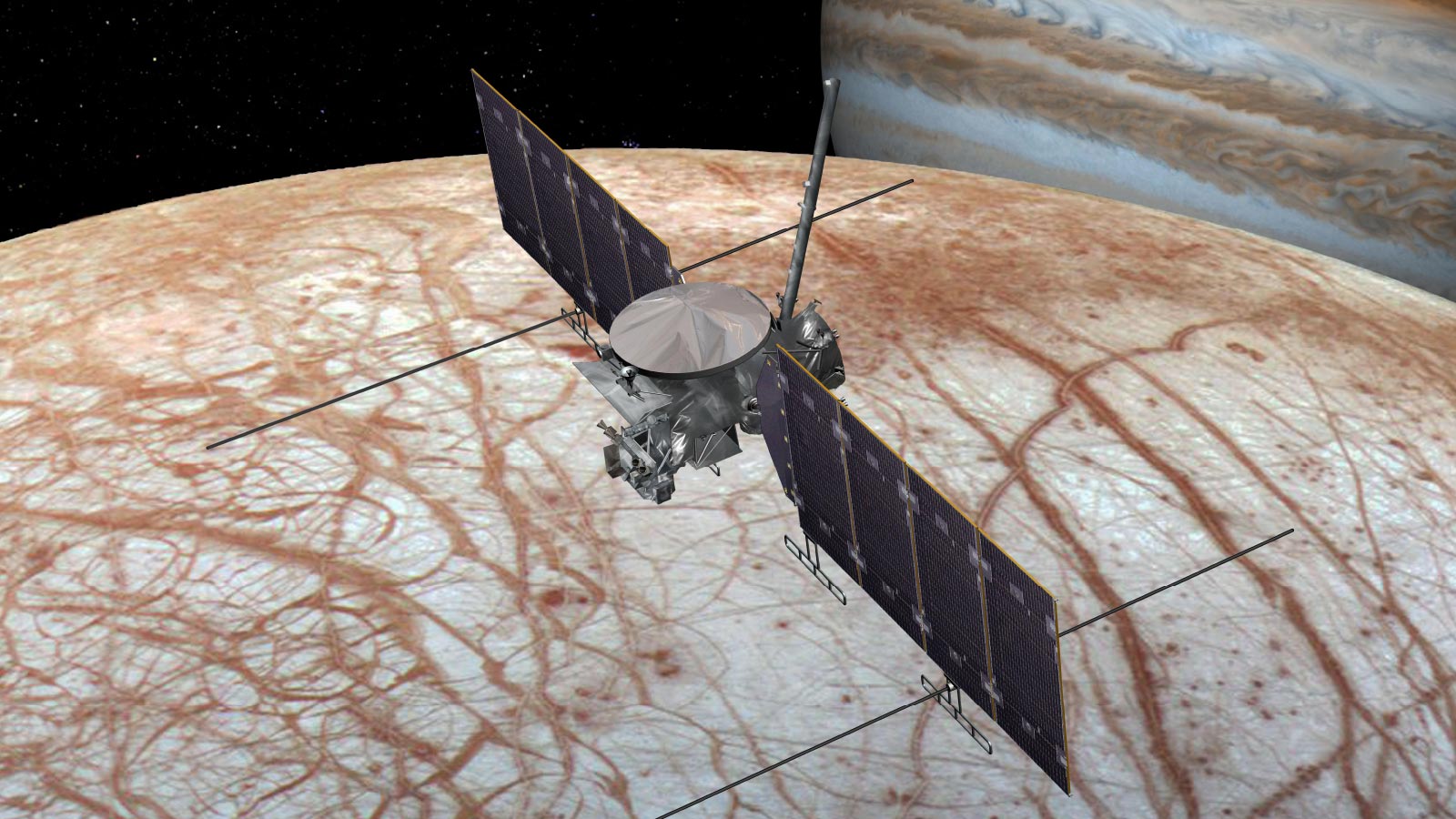Stay Up to Date
Submit your email address to receive the latest industry and Aerospace America news.
The White House wants to steer the launch of NASA’s proposed Europa Clipper spacecraft to a commercial rocket
Space science and technology careers at NASA can push the envelope of one’s biological clock. First you have to persuade the agency to fund your idea, and then it can take five years or longer to design and build the spacecraft.
Consider the Europa Clipper probe whose orbit around Jupiter would send it close to the ice-covered moon Europa, and hopefully through what appear in Hubble images to be plumes of water vapor erupting from its surface. Where there is water there could be life or at least the chemical residue from living organisms.
Scientists at NASA’s Jet Propulsion Laboratory in California began thinking about visiting Europa in some manner after the Galileo probe in 1997 found evidence for saltwater oceans beneath the icy surface. It took until August 2015 to establish the team that will develop the Europa Clipper mission and make key recommendations such as which vehicle to launch it on.
A tacit debate is playing out these days among officials from NASA, the White House and Congress over which rocket to launch Europa Clipper on sometime between 2022 and 2025.
The commercial options are a United Launch Alliance Delta 4 Heavy or perhaps a SpaceX Falcon Heavy. The government-owned option is a Space Launch System rocket in development for NASA by prime contractor Boeing. Aerojet Rocketdyne will provide the RS-25 engines; and Orbital ATK is building the boosters.
What’s the difference? An SLS could get the $4 billion Europa Clipper to Jupiter’s orbit in 2½ to three years. Once in space, the rocket’s exploration upper stage would blast Clipper directly to an orbit around Jupiter that would take it by Europa every 14 days. NASA says a version of SLS with a less powerful interim cryogenic propulsion stage could also carry Clipper on a direct flight.
A Delta 4 Heavy or Falcon Heavy would take several times longer because the SLS will have more thrust at liftoff from four RS-25 engines and two solid rocket boosters. This means the Clipper would have to orbit Venus to gain momentum for a flight to Jupiter’s orbit.
“I’m retiring in a few years, so I won’t see it through if it launches on a 7½-year cruise,” says Barry Goldstein, the Europa Clipper project manager at JPL.
Normally, a decision about the launch vehicle for a high-profile mission like the Clipper belongs to the NASA administrator. The agency says the NASA leader will decide within a year, subject to any legal direction. NASA Acting Administrator Robert Lightfoot announced he is retiring in April, however, and administrator nominee Rep. Jim Bridenstine, R-Okla., is still waiting for Senate approval.
The clear preference among Clipper scientists would be to fly on an SLS, provided it meets the agency’s criteria, but the design has not yet left the ground. “The reliability of SLS depends on maturing manufacturing processes and having a steady cadence of flights. Neither has happened yet,” notes Cristina Chaplain, who directs oversight research into space and missile defense work for the congressional Government Accountability Office.
Enter the Trump administration. The NASA portion of the White House budget request for 2019 proposes launching the Europa Clipper on a Delta 4 Heavy or other “commercial launch vehicle,” saying this “would be several hundreds of millions of dollars cheaper than an SLS flight.” It also bumps the launch to 2025 instead of 2022.
This was an unexpected twist for Europa Clipper scientists and it seems to be headed for a political minefield. The 2017 appropriations bill signed by President Donald Trump requires NASA to “use the Space Launch System as the launch vehicle” for the spacecraft “no later than 2022.”
For Clipper scientists, the message from Rep. John Culberson, R-Texas, chair of the House Appropriations subcommittee in charge of NASA, seems to be don’t fret. The SLS choice is “not debatable,” he tells Aerospace America. Culberson, a strong backer of SLS whose district includes NASA’s Johnson Space Center, says he appreciates the White House’s passion for space exploration but “the final decisions are made in Congress” through NASA authorization and appropriations bills.
“We’ll be able to get science back far more quickly using the SLS,” he says. There is urgency to this mission, he adds, because if signs of life are found on Europa, “that is the kind of civilization-level discovery that NASA needs to inject fresh energy, fresh support for the space program, in general.”
The SLS has a deep bench of supporters on Capitol Hill. Sens. Richard Shelby, R-Ala., and Bill Nelson, D-Fla., have fought attempts to curtail funding for the SLS rockets. The adapters that will release payloads to space are being built at NASA’s Marshall Space Flight Center in Alabama. In Florida, NASA’s Kennedy Space Center, where Nelson once flew from as a shuttle astronaut, has been upgraded as the launch site for the SLS.
There are critics of SLS, too. Delays and cost overruns have drawn criticism from House Science Committee Chairman Lamar Smith, R-Texas, among others. NASA in 2017 pushed the first mission for the rocket, Exploration Mission 1, from 2018 to December 2019. The agency has spent about $8.6 billion on SLS through fiscal 2017 and expects to spend about another $1.2 billion through fiscal 2020.
Given the direction from Congress that was signed off on by Trump, the JPL team continues to prepare Clipper for the 2022 launch deadline set by Congress. Officials there are excited about the prospect of gathering close-up data just a few years after that, if SLS is ready and available.
There could be a big hitch due to SLS’s main job of carrying astronauts on exploration missions. “It is not possible to launch the Clipper on an SLS earlier than 2024 without disrupting current NASA human exploration plans,” according to the White House 2019 budget proposal.
The request proposes 2025 as the launch date to keep SLS “focused on supporting the administration’s new space exploration strategy and prioritizing the return of astronauts to the surface of the Moon.”
Exploration Mission 2 scheduled for 2022 to send astronauts to orbit the moon could conflict with Clipper’s launch date.
Scheduling is a concern, but NASA and Congress want to maximize flights on the SLS so a broad range of missions make the cost of the rockets worthwhile, says James Knauf, a former U.S. Air Force colonel who served as deputy director of space acquisition at the Pentagon. NASA says it would cost $700 million to $1 billion to launch an SLS rocket, including an exploration upper stage, based on its preliminary estimate, according to NASA’s Cheryl Warner. “I don’t have a lot of optimism that they are going to be able to bring the SLS launch cost down,” Knauf says.
The discussion about launch options reflects how “we are at a crossroads” with the creation of more privately owned heavy lift rockets, says Eric Stallmer, president of the Commercial Spaceflight Federation industry association that represents companies including SpaceX.
“I don’t think the White House is anti-SLS,” says Stallmer, who is a member of the National Space Council’s User Advisory Group, representatives from industry and other non-federal entities that “use” or benefit from aerospace technology. The National Space Council is an executive branch board that makes space recommendations to Trump.
“The White House is very keen on the greatest utilization of commercial products when possible,” Stallmer says.
Delta 4 Heavy has been the main contender against SLS, but Clipper officials noted the Falcon Heavy debut launch in February. Goldstein says the performance data from that launch sent by Kennedy Space Center indicates the Falcon Heavy would likewise be unable to fly directly to Jupiter, and would arrive at a similar time as the Delta 4 Heavy by getting a momentum boost after orbiting Venus. Both rockets have a payload fairing large enough to carry the Europa Clipper. SpaceX founder Elon Musk has said a fully expendable Falcon Heavy would cost $150 million per launch. ULA and NASA did not provide launch cost estimates for the Delta 4 Heavy.
Uncertainty about which rocket will launch the Clipper makes designing the probe more challenging and more expensive, Goldstein says. The probe is being designed with additional thermal shielding in case it flies close to Venus on a trajectory to reach the Jovian moon, he says, adding that the preliminary design review for the Clipper is in August.
Flying Clipper on a longer route to Jupiter orbit would also mean spending more on NASA employees to monitor the spacecraft. There are only rough models for that potential expense but it would “definitely be less than the difference in the cost” between SLS and another rocket, says Joan Salute, program executive for Europa Clipper at NASA JPL.
If patience is called for, that won’t be something new for the planetary scientists involved with Clipper. Planetary science missions can last 20 years, so their teams often expect not be at NASA for the end of their missions and train replacements to continue operations after they retire.
“Any biogenic material, any bacteria that may be there in the water plumes, will likely be there years from now, so I don’t know if there is urgency that requires the SLS to fly Europa Clipper,” says Jack Burns, an astrophysicist at the University of Colorado who served on Trump’s NASA transition team.
Europa
NASA was so optimistic about the chance for life-supporting conditions on Europa that it concluded the Galileo in 2003 by flying the probe into Jupiter to avoid contamination from a potential crash into the moon.
“The reliability of SLS depends on maturing manufacturing processes and having a steady cadence of flights. Neither has happened yet.”
Cristina Chaplain, Government Accountability Office
About Tom Risen
As our staff reporter from 2017-2018, Tom covered breaking news and wrote features. He has reported for U.S. News & World Report, Slate and Atlantic Media.
Related Posts
Stay Up to Date
Submit your email address to receive the latest industry and Aerospace America news.






